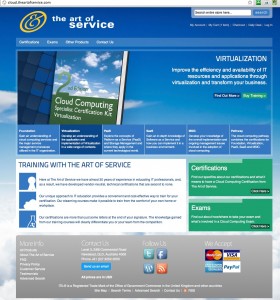Cloud Computing, IT consolidation & ITIL
One of the major problems facing large-scale IT operations is a lack of cohesiveness, or simplicity of operation. While it might seem as though increased complexity merely opens the door to additional possibilities, this isn’t the case when things become so scattered and complex as to create or foster miscommunication (or absence thereof). The main aim behind the IT consolidation movement was / is to create more standardization across multiple platforms, systems, infrastructures and working bodies so that waste and exorbitant expenditures can be slashed.
Virtualization has long been associated solely with cloud computing however it is important to note that they are not the same thing (though they both tap into similar technologies). For instance, a traditional non-cloud architecture model can still utilize or integrate virtualized elements. To be considered truly “cloud” you have to have nearly a complete move toward the centralization of all IT assets, especially those on the user end of the spectrum. One of the chief benefits of cloud computing is that it allows a smaller group of IT professionals to manage a much larger pool of resources, all from one location.
Before we jump into how cloud computing can assist in, or even perhaps replace our current notions of what IT consolidation is, or is capable of, let’s examine some of the benefits (of IT consolidation). Though the true benefits of IT consolidation are highly debatable, there are essentially four principal reasons why it is preferable:
- Streamlined Modifications / Amendments – By having a solid IT consolidation policy in place it is much easier to modify existing systems in order to incorporate newer / better components as well as correct minor issues without jeopardizing service delivery.
- Unproblematic Management of Assets – A truly consolidated IT organization allows management to perform their duties in a much cleaner and more efficient fashion. They are able to spend more time assessing and meeting goals and less time attempting to organize existing infrastructure (or personnel).
- Better Exploitation of Resources – If you want to succeed in IT, you must be able to help deliver upon expectations and perhaps even bend to facilitate your client’s business model. Through IT consolidation it is possible to gain a clear understanding of what resources are available and how they might be better used (perhaps even in an unexpected / unconventional, yet highly functional manner).
- Enhanced Security and Data shielding – Of the many concerns facing IT groups in the modern world, security and the ability to protect data from breach or attack has to be at the top of the list. Most of the data and systems that IT is charged with utilizing and protecting are often vital / crucial to the success of the businesses they service; in other words, a security breach could very well lead to downtime, which is the same thing as lost profits. IT consolidation can not only help identify potential risks in this regard, it can also help put measures in place to combat such actions as well.
In many ways, cloud computing is as much another form of IT consolidation as it is a new approach to IT and computing / networking. This is largely because cloud computing, by its very nature, is concerned with the centralization of assets, which basically requires that (at some point) a complete “inventory” be taken, and a strict organization of assets be initiated. In this way, establishing or transitioning to a cloud infrastructure is in many ways adhering to the four concepts listed above. For example, cloud computing allows for the establishment of much cleaner, accessible and more direct management of all IT resources from one central location, which should more than satisfy any requirements needed for successful IT consolidation.
Additionally, methodology frameworks like ITIL can be leverage to provide additional support toward establishing a cloud infrastructure (in terms of both the infrastructure itself as well as the micro-management of personnel). This is because many of the components found embedded in various individual cloud services are likely to have been developed in a traditional IT environment utilizing ITIL, for example. Aside from any implications concerning how ITIL might be used to “build a better cloud”, it is still one of the leading technical certifications that IT professionals can attain. Additionally, it should be noted that ITIL is a perfect reflection of the wisdom and research of countless respected IT gurus; it should go without saying that if you want to make a mark in any particular industry, it’s probably best to study what the “greats” have to impart upon you, so to speak.
While IT consolidation should always be considered to be a step in a positive direction, we should keep our minds open to the possibilities intrinsic to cloud computing, as it is capable of achieving nearly the same ends (with perhaps even greater benefits). Given the fact that there is currently a big industry-wide push toward cloud computing, it is advisable that careful thought be given as to how your organization is planning to adopt and take advantage of cloud technologies.
Interesting in learning more about ITIL certification, please visit this site.
To check out various cloud computing certification programs, click here.
